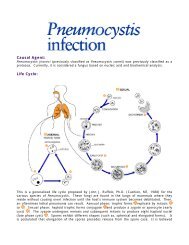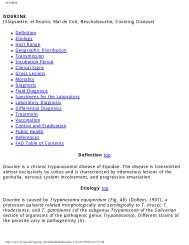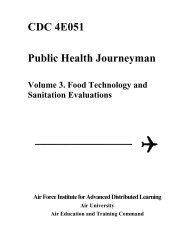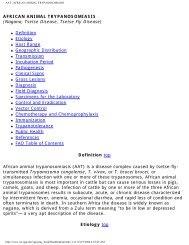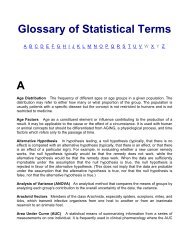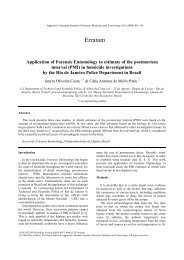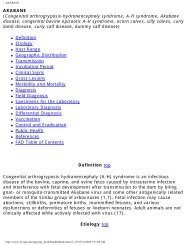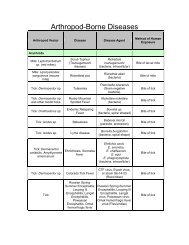HEMORRHAGIC SEPTICEMIA
HEMORRHAGIC SEPTICEMIA
HEMORRHAGIC SEPTICEMIA
Create successful ePaper yourself
Turn your PDF publications into a flip-book with our unique Google optimized e-Paper software.
<strong>HEMORRHAGIC</strong> <strong>SEPTICEMIA</strong><br />
nasal discharge appear, and edematous swellings are seen in the pharyngeal<br />
region and then spread to the ventral cervical region and brisket. Visible mucous<br />
membranes are congested, and respiratory distress is soon followed by collapse<br />
and death. Recovery, particularly in buffaloes, is rare. Chronic manifestations of<br />
hemorrhagic septicemia do not appear to occur.<br />
Gross Lesions top<br />
Widely distributed hemorrhages, edema, and general hyperemia are the most<br />
obvious tissue changes observed in infected animals. In almost all cases there is<br />
an edematous swelling of the head, neck, and brisket region (Fig. 63). Incision of<br />
the edematous swellings reveals a coagulated serofibrinous mass with strawcolored<br />
or blood-stained fluid. This edema, which distends tissue spaces, is also<br />
found in the musculature (Fig. 64). There are subserosal petechial hemorrhages<br />
throughout the animal, and blood-tinged fluid is frequently found in the thoracic<br />
and abdominal cavities. Petechiae may be found scattered throughout some<br />
tissues and lymph nodes, particularly the pharyngeal and cervical nodes, which<br />
are also swollen and often hemorrhagic. Pneumonia is not usually extensive nor is<br />
gastroenteritis. Cases that are atypical in regard to throat swelling (absent) and<br />
pneumonia (extensive) are occasionally seen.<br />
Morbidity and Mortality top<br />
Husbandry, weather and immunity affect morbidity. In endemic areas, from 10 to<br />
50 percent of the cattle or buffalo populations acquire solid immunity through<br />
exposure or subclinical infection. Close herding and wetness predispose to an<br />
increased morbidity. Most animals that develop clinical signs die.<br />
Diagnosis top<br />
Field Diagnosis top<br />
In countries where hemorrhagic septicemia is endemic, it is usually readily<br />
diagnosed — particularly if there is a history of previous outbreaks and a failure to<br />
vaccinate. When a small number of animals are affected, diagnosis may be more<br />
difficult. This could be the case if hemorrhagic septicemia were to occur in the<br />
United States. In endemic areas, the rapid course, usual high herd incidence, and<br />
the appearance of edematous swellings in the throat, cervical, and parotid regions<br />
is highly suggestive.<br />
Specimens for the Laboratory top<br />
http://www.vet.uga.edu/vpp/gray_book/Handheld/hes.htm (4 of 8)3/5/2004 4:15:01 AM





